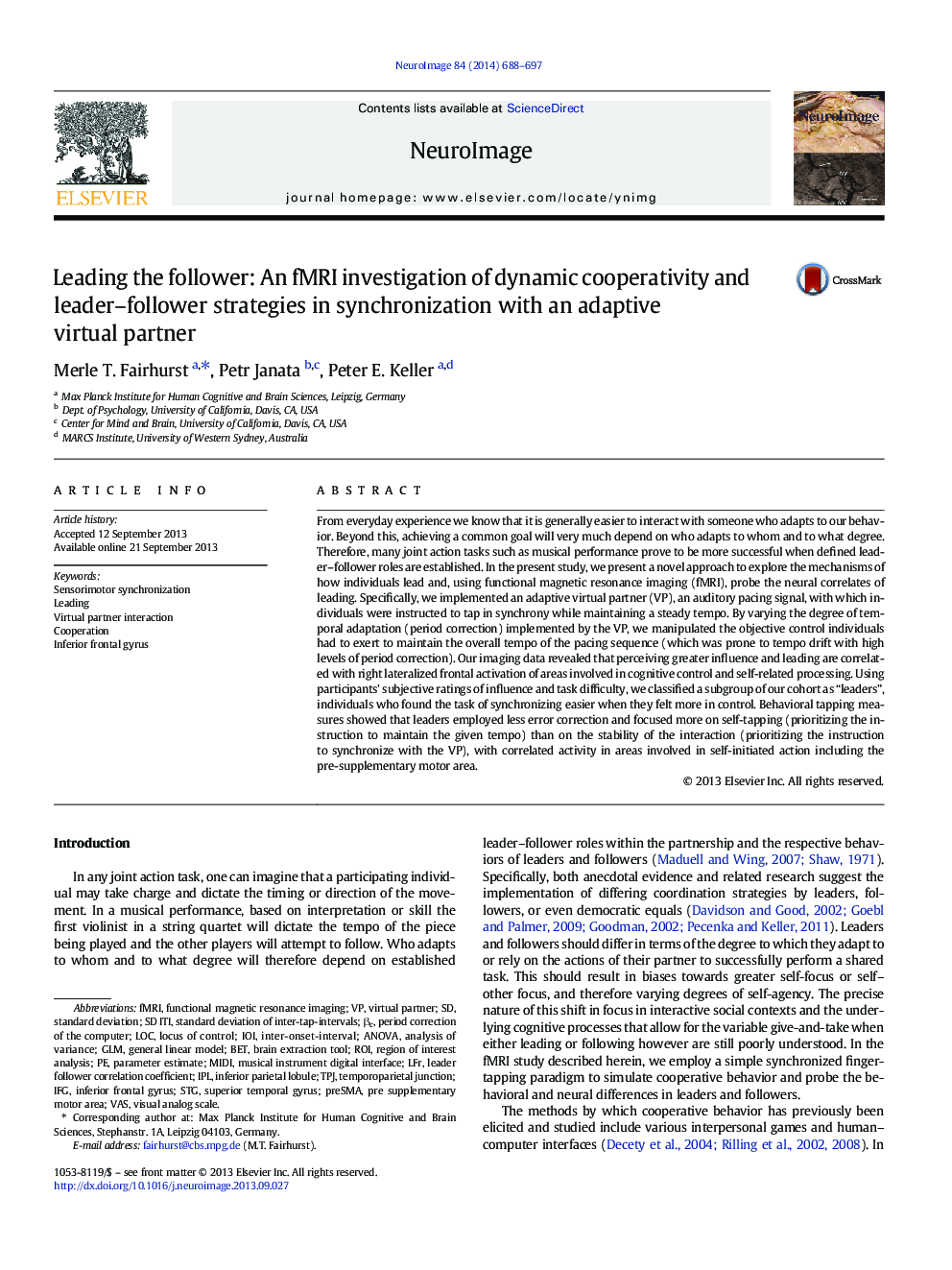| کد مقاله | کد نشریه | سال انتشار | مقاله انگلیسی | نسخه تمام متن |
|---|---|---|---|---|
| 6028572 | 1580920 | 2014 | 10 صفحه PDF | دانلود رایگان |
عنوان انگلیسی مقاله ISI
Leading the follower: An fMRI investigation of dynamic cooperativity and leader-follower strategies in synchronization with an adaptive virtual partner
دانلود مقاله + سفارش ترجمه
دانلود مقاله ISI انگلیسی
رایگان برای ایرانیان
کلمات کلیدی
MIDIIPLTPJIFGRegion of interest analysisStgROIβCGLMLFRpreSMAVASLocus of control - منبع کنترل Brain extraction tool - ابزار استخراج مغزTemporoparietal junction - اتصال موقوپاپاریتالstandard deviation - انحراف معیارIoI - ایو ایParameter estimate - برآورد پارامترanalysis of variance - تحلیل واریانسANOVA - تحلیل واریانس Analysis of variancefunctional magnetic resonance imaging - تصویرسازی تشدید مغناطیسی کارکردیfMRI - تصویرسازی تشدید مغناطیسی کارکردیsuperior temporal gyrus - جورج جادویی عالیBET - شرطinferior frontal gyrus - قارچ پیشانی پایین ترinferior parietal lobule - لوبوئین ترموس پایینLoc - محلGLM, General Linear Model - مدل خطی عمومیvisual analog scale - مقیاس آنالوگ بصریleading - منتهی شدنsensorimotor synchronization - هماهنگ سازی سنسور حرکتیCooperation - همکاری
موضوعات مرتبط
علوم زیستی و بیوفناوری
علم عصب شناسی
علوم اعصاب شناختی
پیش نمایش صفحه اول مقاله

چکیده انگلیسی
From everyday experience we know that it is generally easier to interact with someone who adapts to our behavior. Beyond this, achieving a common goal will very much depend on who adapts to whom and to what degree. Therefore, many joint action tasks such as musical performance prove to be more successful when defined leader-follower roles are established. In the present study, we present a novel approach to explore the mechanisms of how individuals lead and, using functional magnetic resonance imaging (fMRI), probe the neural correlates of leading. Specifically, we implemented an adaptive virtual partner (VP), an auditory pacing signal, with which individuals were instructed to tap in synchrony while maintaining a steady tempo. By varying the degree of temporal adaptation (period correction) implemented by the VP, we manipulated the objective control individuals had to exert to maintain the overall tempo of the pacing sequence (which was prone to tempo drift with high levels of period correction). Our imaging data revealed that perceiving greater influence and leading are correlated with right lateralized frontal activation of areas involved in cognitive control and self-related processing. Using participants' subjective ratings of influence and task difficulty, we classified a subgroup of our cohort as “leaders”, individuals who found the task of synchronizing easier when they felt more in control. Behavioral tapping measures showed that leaders employed less error correction and focused more on self-tapping (prioritizing the instruction to maintain the given tempo) than on the stability of the interaction (prioritizing the instruction to synchronize with the VP), with correlated activity in areas involved in self-initiated action including the pre-supplementary motor area.
ناشر
Database: Elsevier - ScienceDirect (ساینس دایرکت)
Journal: NeuroImage - Volume 84, 1 January 2014, Pages 688-697
Journal: NeuroImage - Volume 84, 1 January 2014, Pages 688-697
نویسندگان
Merle T. Fairhurst, Petr Janata, Peter E. Keller,